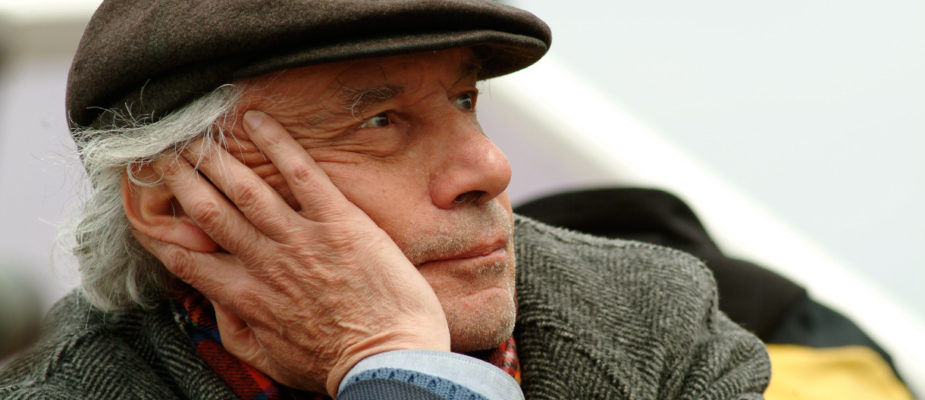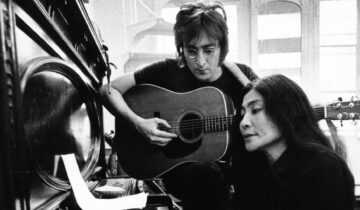Filmmaker and critic Jacques Rivette (1928-2016) has meant a great deal to me for most of my life as a serious cinema-goer: In 2001, I wrote my undergraduate thesis on the liberational aspects of the director’s masterpiece, Celine and Julie Go Boating (1974); three years later, I managed my first publication with a piece on his then-latest, Story of Marie and Julien (2003); his brilliant writings on Howard Hawks — he was perhaps the most perceptive of his generation of filmmaker-critics — contributed mightily to my appreciation and later scholarship on the Hollywood director (who, ultimately, became the subject of my dissertation); and as a programmer, I brought the director’s 13-hour magnum opus Out 1: Noli me Tangere (1971) to Oklahoma City last fall. The four nights of screenings did not reach a wide audience, regretfully, but for me at least, the experience will be one I may never replicate.
When I first encounter Jacques Rivette’s name in the late 90’s, in James Monaco’s The New Wave : Truffaut, Godard, Chabrol, Rohmer, Rivette (1976), Rivette’s stature wasn’t what it is today. He was a distant fifth on the list of nouvelle vague critic-directors (which is meant as no slight to Monaco; Rivette bloomed later than his New Wave cohort). He was known mostly as the director of really long, vaguely hippyish films that few people saw. The one exception was his La Belle noiseuse (1991), still four hours and quite outstanding in its own right (as one of the great films about the act of painting), which nonetheless earned most of its attention in the video-store era for its sexy nude cover art. Suffice it to say that most people who saw La Belle noiseuse would go no further into Rivette’s corpus.
For me, however, Rivette came along at exactly the right time — perhaps just as he did for those who were in New York around the time the Museum of the Moving Image belatedly screened Out 1 in the mid-to-late 2000’s. (I did not see it at that time, as I had since relocated to New Haven, but I did manage to catch his four-hour edit, Out 1: Spectre, 1972, at Anthology Film Archives). Though I loved (and still love) the films of his fellow New Wave auteur Eric Rohmer the most, Rivette’s work always gave me the most to think about. Looking back, it was Rivette’s appearance at precisely the moment I was also learning the hermeneutic codes of Modernism — especially as they applied to painting — that led me to connect deeply with his art. His was also an art that mysterious, magically seemed to fuse the spatial organization of Mizoguchi with the “invisibility” of Hawks, masters of both Rivette and my own young cinephilic self; in addition to being a source for future passions including Louis Feuillade.
In Rivette, I suppose, I saw a fellow Modernist traveler, someone who was creating an art (from a Greenbergian perspective) that was above all about itself and its process of creation, even as it was grounded in the very best of film history. Performing rudimentary psychoanalysis at the time, it made sense that someone who so devoted his life to film would, ultimately, create works about his life’s vocation; and, from my perspective today, I can see why this appealed to a twenty-two year-old who spent hundreds of hours watching and thinking about the art form. Above all, Rivette’s work and critical writings were aspirational and instructive for the new life I was beginning, one that I imagined at the time would lead me to filmmaking.
Along with the rest of his New Wave cohort and the Left Bank Group (primarily Jacques Demy, Chris Marker, Alain Resnais, and Agnès Varda), Rivette’s filmmaking generation played an enormously significant role in the history of the visual arts. Rising to adulthood in cinema-mad Paris in the years immediately following World War II, with hundreds of banned Hollywood films belatedly hitting French screens, Rivette and company succeeded in discovering the artistry (and most importantly, the artist–the director) in the classical system that had prevailed since the rise of D.W. Griffith in the 1910’s. They developed an interpretative system, auteurism (modeled on classical art-historical analysis), which as it happened, also coincided with the rise of the personal art-film in the works of directors such as Ingmar Bergman and Roberto Rossellini. When they began making their own films in the 1950s and 1960s, they would proceed with a newfound self-consciousness, with respect to both their role as author and also their place in film history, thereby extending their critical project at iconic French film magazine Cahiers du cinéma. Cinema, not that it hadn’t always been, had become an art. And not just an art, but the art for a certain segment of the mass cultured public.
In a sense, cinema had filled the cultural “lane” that painting had long occupied, thanks both to a generational turning and to cultural factors like the aforementioned return of classical Hollywood film art, and also to the fact that the European avant-garde had since dispersed (mostly to America) leaving Henri Matisse and Pablo Picasso, most prominently, and not for too much longer, in France. Not only would America steal the art world, as it goes, but the new painting that would emerge there reached a new level of abstraction that would exceed the interpretative capacity of most (even cultured) audiences. In a sense, the important postwar painting, which was now centered in New York rather than Paris — not that Matisse and Picasso weren’t still at the very top of the mountain — came to occupy a new “lane,” one that though prominent in one sense, especially in select urban circles, was not exactly mass. As painting crossed the thresholds of Pop, Minimalism and later Conceptualism, this new place, on the remote edge of culture, was all but assured. In its former more mass place was a modernist cinema, one that in its dissociative properties — as seen most of all in the work of Jean-Luc Godard and again Rivette — referenced the then still-living Picasso most of all. It was not only as if New York had stolen the art world from Paris, but that cinema had stolen (the cultural significance and position of) that city’s signature oil-painting medium too.
While the New Wave would prove short-lived — some arguing that it was over as early as 1962; others insisting that it lasted until at least Rivette’s Celine and Julie Go Boating — its impact in the formulation of a Modernist art cinema remains evergreen to the extent that the experimental (“parametric”) narrative cinema remains the most interesting source of new cinema (which, in persons such as Apichatpong Weerasethakul and Lisandro Alonso I would argue it does). Of course, it’s also clear that serious cinema doesn’t occupy the same “lane” it did during the heyday of the New Wave, increasingly becoming what abstract painting was in the postwar decade.
Returning to Rivette, it was one of the privileges of my film-going life to be there at the end of his career, to anticipate the final works by a true master, beginning with 2001’s Va Savoir!. I can only imagine that seeing a new Rivette in the late 2000’s, or a Rohmer or Manoel de Oliveira for that matter, was similar in experience to being young and there for the last works of John Ford, Alfred Hitchcock or Jean Renoir — not to mention Matisse and Picasso in postwar Paris. He was one of the old masters that my generation was given, just as he had been (without enough knowing it, perhaps) one of the medium’s greatest artists during its late 1960s, early 1970s apogee, the period when he made his supreme masterpieces, Out 1, Celine and Julie Go Boating, and L’Amour fou (1969). Though the last of these is still rarely screened, we do at least now live in a world where many of his greater works have and can be (somewhat easily) seen, and where Rivette is regularly judged to be something more than an also-ran in the history of the New Wave. Rivette will remain one of the great critic-directors who made cinema modern, and in the process, made cinema the modern art.










